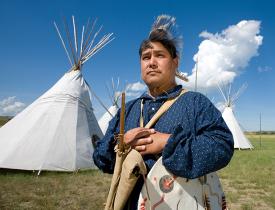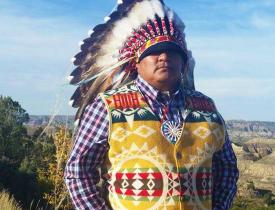Rob Hanna: Lewis and Clark Interpretive Center and Fort Mandan
“I want to share history with people, and I like to see the excitement in their eyes as they discover something that they hadn’t thought about before or see something in a new way.”
Rob Hanna’s love for history was cultivated by the way his parents raised him. “They went out of their way to make history relevant to me, so I’m just passing on what I learned from them,” he says.
Throughout his career, Rob has shared this area’s heritage with all kinds of people, from European film crews to vacationing families to local school groups. The heritage he shared at Fort Mandan and the Lewis and Clark Interpretive Center began with legends like Lewis and Clark, Sakakawea and Mandan Chief Sheheke-Shote. “I love meeting the people who come here and interacting with them,” Rob explains. “People who come here tend to be just really interested in the stories that we’re telling and it’s just so rewarding to share this North Dakota heritage with people from all over the world who came with no other desire than to learn about it.”
In addition to telling the stories, staff members at Fort Mandan engage in preserving history. They reintroduced Native American games that used to be played by area tribes, like double ball and hoop and dart. The staff recently discovered that when they initiate playing these traditional games with kids and families that visit, regional kids not only recognize these traditional games, but have played them as well. “It’s just so wonderful to be a part of helping to literally bring that heritage back and have the North Dakota community aware of its own history like this … Things that were almost lost,” Hanna says.
Hanna and the staff also work hard to make the visitor experience unique. “If you’ve come all the way to Fort Mandan, I don’t want you to read a book on the wall. I want you to pick up some stuff, I want you to try some food,” Hanna notes. “I want you to wear some clothes and play some games; do the things you can only do while you are here. We do that a lot and visitors are loving it.”
Having that tangible experience helps visitors connect to the story and start to understand the real people and relationships behind the legendary story. “At Fort Mandan, Lewis and Clark had a really successful positive relationship with the Mandans as they did with Lewis and Clark, and we could stand to benefit by understanding better how they did it,” Hanna says.
Since this interview took place, Rob has transitioned to a new position as one of two Historic Sites Managers with the State Historical Society of North Dakota. In this position, he oversees eight sites around North Dakota, including the Former Governors Mansion, 1883 Stutsman County Courthouse, Welk Homestead, Whitestone Hill, and Pembina State Museum. He’s delighted to help share personal and hands-on experiences of history with even wider audiences.
In addition to the sites he oversees and Fort Mandan, Rob recommends visiting:
- Knife River Indian Villages National Historic Site – where Sakakawea lived before joining the Lewis and Clark Expedition.
- On-A-Slant Village at Fort Abraham Lincoln State Park – where Chief Sheheke grew up.
- North Dakota Heritage Center and State Museum – for a great overview of North Dakota history.
- Any of the sites along the Lewis and Clark National Historic Trail.
- North Dakota tribal powwows.
- Tribal reservations in the area.
“We want the experience that visitors have here to be relevant to their lives and to be purposeful,” Hanna said, “that they’ll leave here inspired, with something that they can take away for their own lives to make it better.”







